A selection of our Spring 2020 courses. For the complete listing, go to Courses.
CHIN 409 Social Science Readings in Chinese
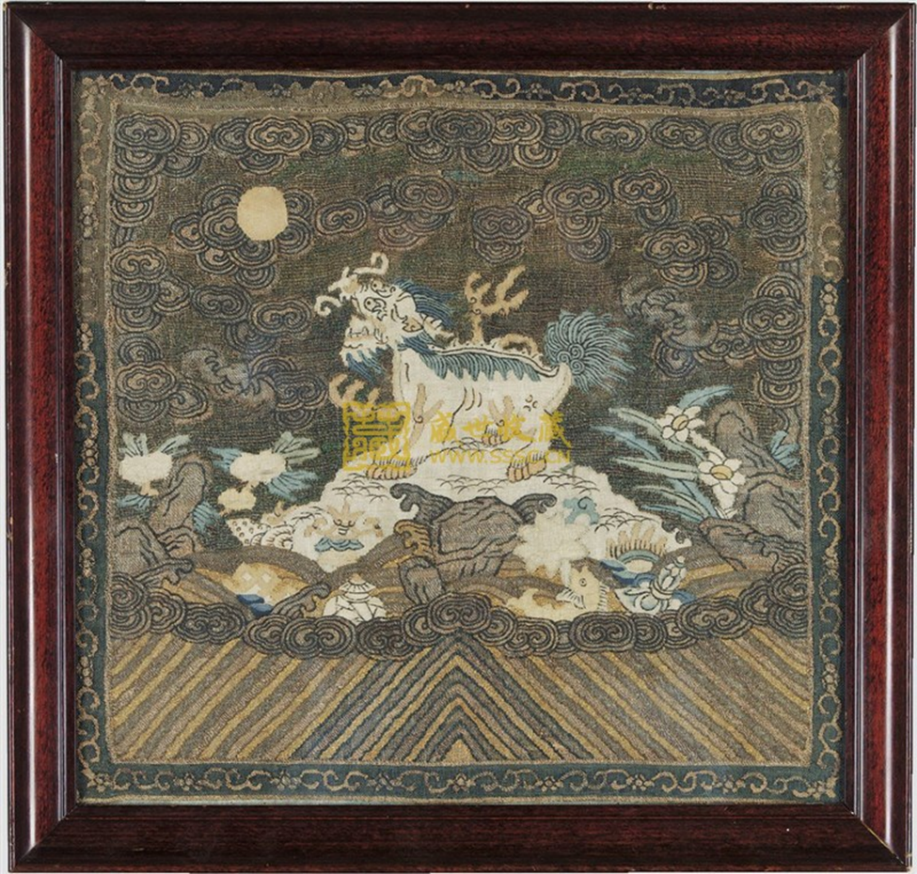
This course introduces students to scholarly readings and primary materials on modern and contemporary Chinese society. This year the course theme is Cultures of Law in China (1900s-present). Course materials include varied genres: literature, legal codes, academic writings, news reports, governmental documents, archival excerpts, as well as visual materials.
Students (including heritage students and native speakers) will be trained in not only reading comprehension and vocabulary enhancement but also critical thinking, cross-disciplinary analysis, translation practice, as well as communication skills needed for and formal presentation and academic discussion in putong hua.
Request for using this course as a substitute for an EALC400-level course will be considered on a case-by-case basis.
Instructor: SHAO Dan (danshao@illinois.edu)
Time and Location: TR 2:00 pm - 3:20 pm, 1046 Foreign Languages Building
EALC/CWL 230 Popular Cultures of Contemporary East Asia

The course provides a wide-ranging introduction to the popular cultures and subcultures of China, Korea, and Japan through exposure to popular films, music, anime, games, and everyday practices. Already hugely popular in its home countries, East Asian popular culture has become familiar to American audiences through films, videogames, food, toys, and comic books. The course explores the historical, social, cultural, and economic roots of this global appeal, while gauging popular culture’s impact on national identity, gender, and lifestyle. The course fulfills the Non-Western Cultures and Literature and the Arts General Education requirements. No knowledge of East Asian languages or previous coursework in East Asian studies is required.
Instructor: G. Persiani (gp2029@illinois.edu) Time and Location: TR 12:30 pm - 1:50 pm Gregory Hall 205
EALC 398 The Visual Culture of Japanese Buddhism
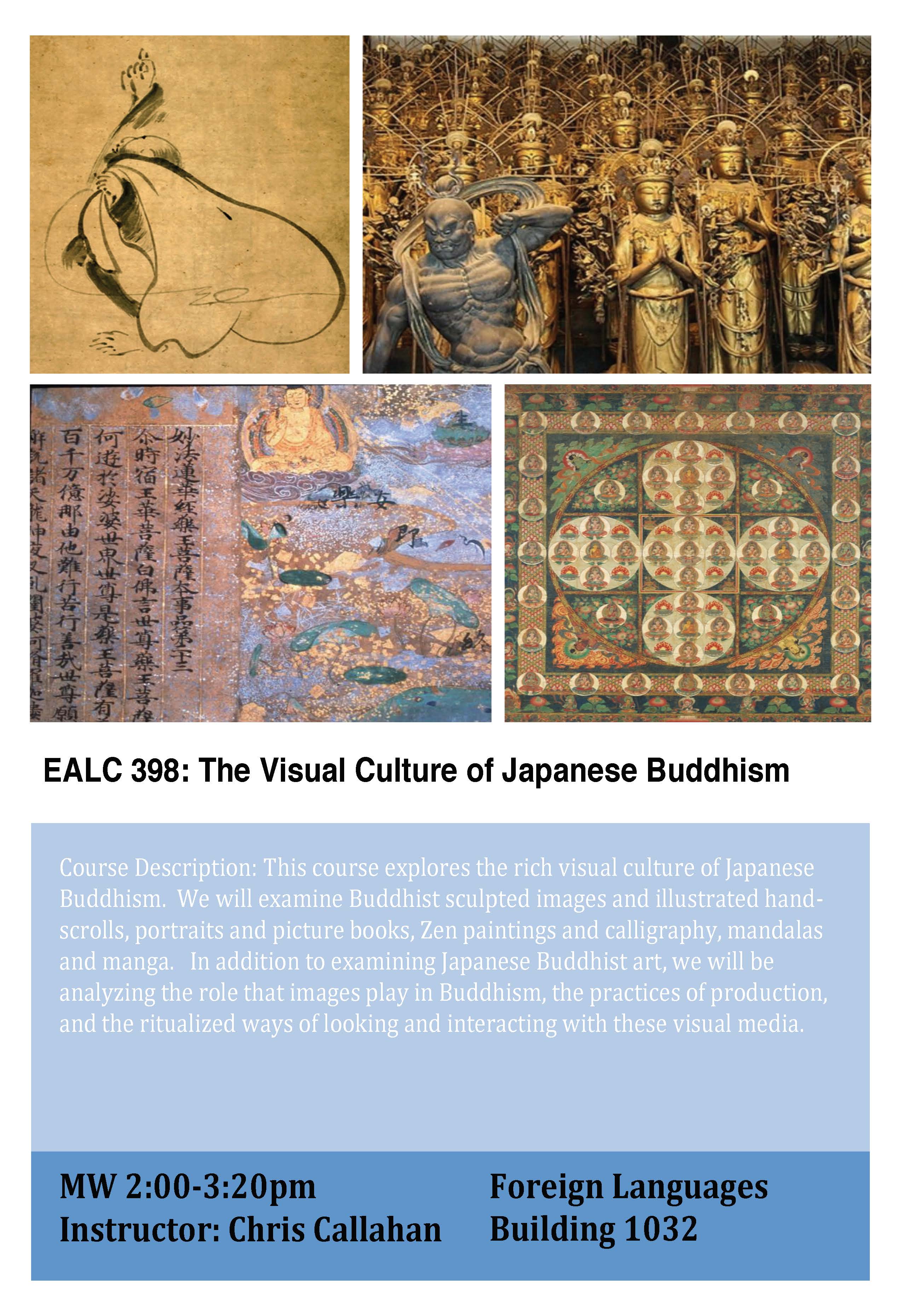
This course explores the rich visual culture of Japanese Buddhism. We will examine Buddhist sculpted images and illustrated handscrolls, portraits and picture books, Zen paintings and calligraphy, mandalas and manga. In addition to examining Japanese Buddhist art, we will be analyzing the role that images play in Buddhism, the practices of production, and the ritualized ways of looking and interacting with these visual media.
Instructor: Chris Callahan
Time and location: MW 2:00-3:20pm, Foreign Languages Building 1032
EALC 398 section CIC (61666) Traditional Korean Poetry TF 10:30-11:50 am, FLB G 96
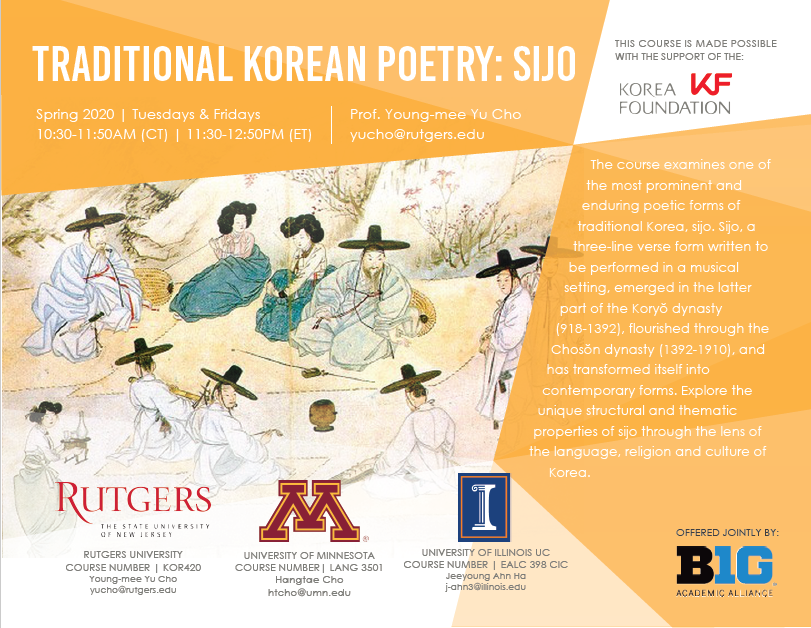
The course examines one of the most prominent and enduring poetic forms of traditional Korea, sijo. Sijo, a three-line verse form written to be performed in a musical setting, emerged in the latter part of the Koryŏ dynasty (918-1392), flourished through the Chosŏn dynasty (1392-1910), and has transformed itself into contemporary forms. First, we will situate sijo within the larger context of traditional East Asian poetic tradition, and then explore its unique structural and thematic properties through the lens of the language, religion and culture of Korea. Lastly, we will analyze the historical backgrounds of modified sasŏl sijo of the 18th century and modern sijo of the 20th century, and uncover cultural and linguistic implications of sijo translation and the current popularity of sijo in North America.
JAPN408/EALC550 - Readings in Classical Japanese
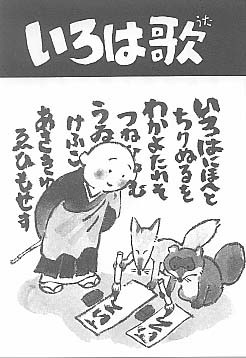
Readings in texts in classical Japanese selected from historical and literary sources of pre-1945 Japan. Attention is given to grammatical, morphological, and stylistic features and to problems in translation. Introduction to reading of classical syllabaries and manuscript texts. 3 undergraduate hours. 4 graduate hours (graduate students should register for EALC550 Classical Japanese). Prerequisite: JAPN 407 or equivalent or advanced Japanese (contact instructor to check eligibility).
TR 3:30 pm - 4:50 pm Foreign Languages Building 1032
EALC 398 section CI2 (70397) Language and Society of Two Koreas MW, 2:00PM - 3:15PM, FLB G 96

This course is designed to offer an introduction and contrastive analysis of the language and society of the two Koreas; the Republic of Korea (better known as South Korea) and the Democratic People’s Republic of Korea (better known as North Korea) with a heavier emphasis on North Korea. This course will introduce the growing divide of the past 70 years between North and South Korea in the areas of language, society, and culture. The complexity of the East Asian region is partly due to the issues involving the two Koreas; however, knowledge regarding North Korea remains very limited compared to its neighbors. Mass media portrays the controversial political and human rights issues of North Korea but generally lacks in coverage of linguistic issues and everyday life there. The course content will be based on various scholarly articles and book chapters, current web-based resources, news reports, North Korean propaganda, and documentaries. While this course will include linguistic elements of interest to intermediate and advanced students of the Korean language, all course content will be accessible to students regardless of Korean language proficiency. This course has no pre-requisites and does not expect students to have a background in political science, Korean history, or sociology, nor a background on North Korea. It does however expect that students have some interest in these areas.
RLST 287 (EALC 287) Introduction to Buddhism
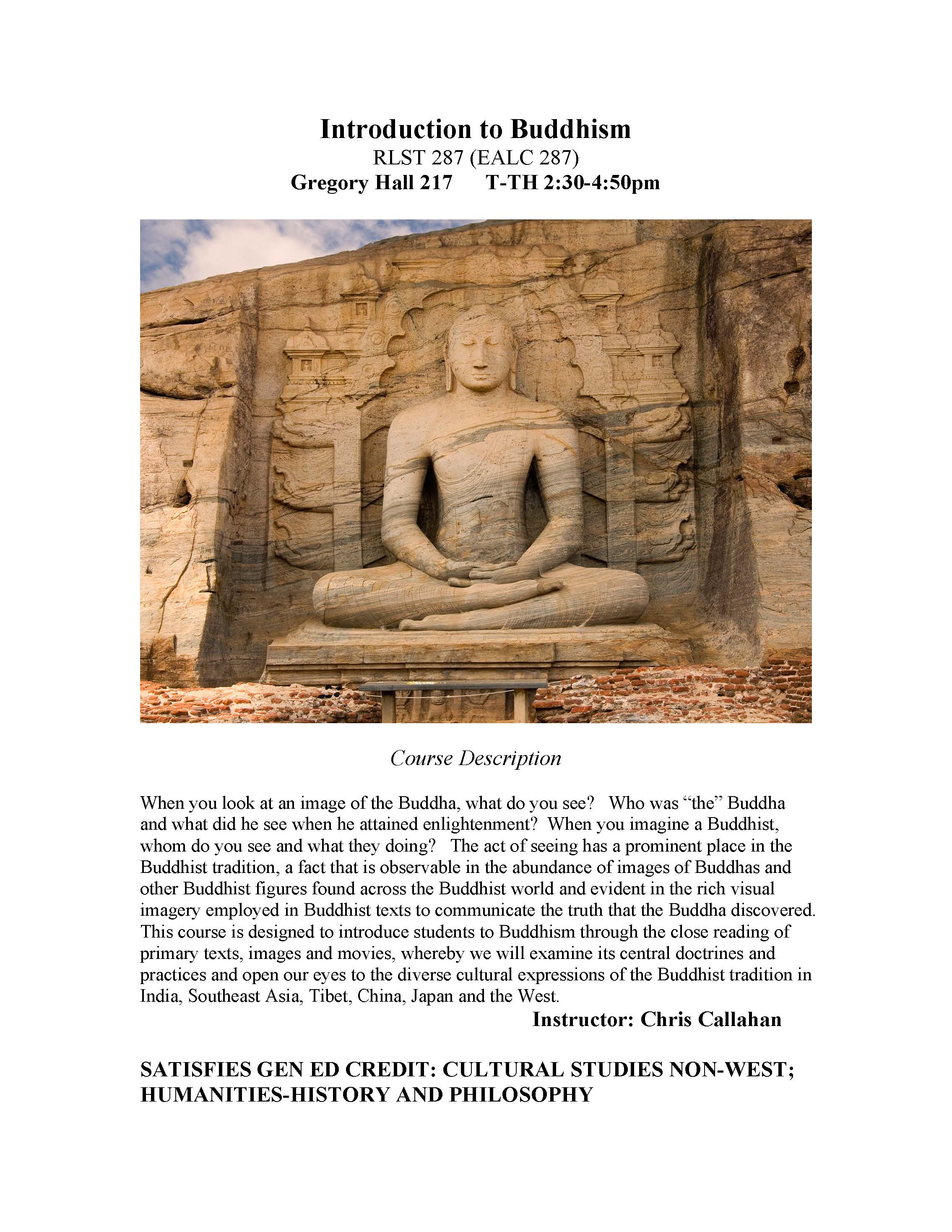
When you look at an image of the Buddha, what do you see? Who was “the” Buddha and what did he see when he attained enlightenment? When you imagine a Buddhist, whom do you see and what they doing? The act of seeing has a prominent place in the Buddhist tradition, a fact that is observable in the abundance of images of Buddhas and other Buddhist figures found across the Buddhist world and evident in the rich visual imagery employed in Buddhist texts to communicate the truth that the Buddha discovered. This course is designed to introduce students to Buddhism through the close reading of primary texts, images and movies, whereby we will examine its central doctrines and practices and open our eyes to the diverse cultural expressions of the Buddhist tradition in India, Southeast Asia, Tibet, China, Japan and the West.
Gregory Hall 217 T-TH 2:30-4:50pm
EALC 466 Japanese Cinema
EALC 466 (Spring 2020)
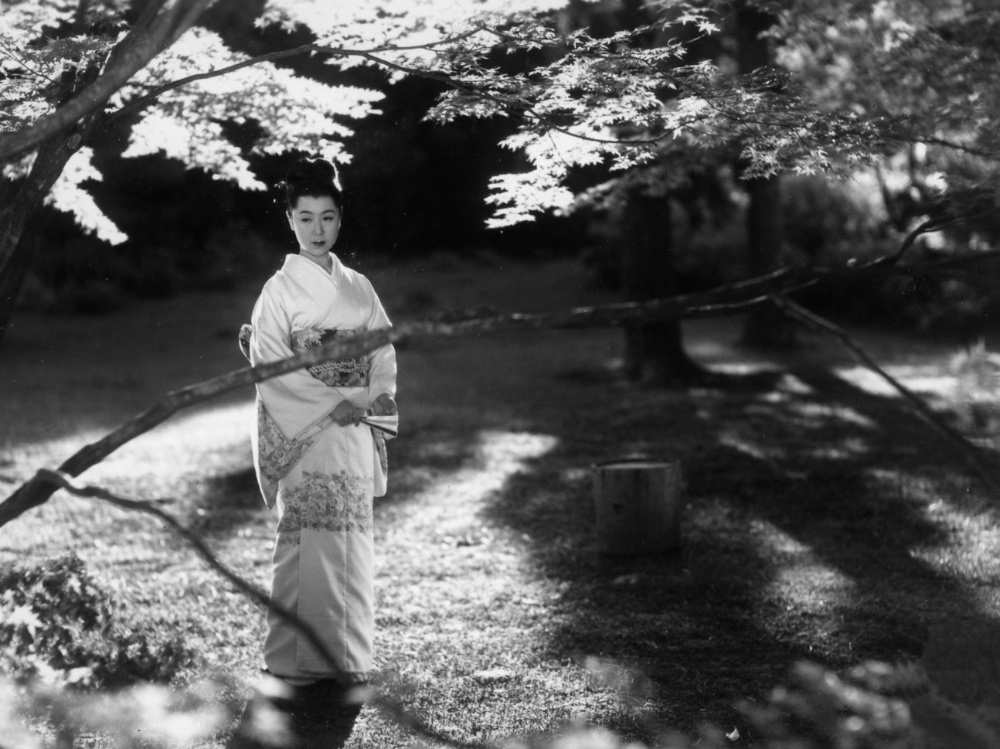
This course surveys Japanese cinema from its early history to the contemporary period following a roughly chronological order. We will use (but also question) concepts such as ?auteur, genre, national traditions, gender and racial hierarchy, culture, Commercial vs. Art, Tradition vs. Modernity, the East and the West? to understand Japanese films. We will focus on both the cultural contents and formal aspect. Whether it is the production of films or their reception by audiences, the art of cinema has always been a social practice shaped by technology, social change, ideological demands, politics, not to mention the history of earlier films. Each week we will view a "moment" from the history of Japanese cinema and a methodological issue in film studies brought into focus by a film. For example, we will study modernism in the 1930s Japan, the war film and propaganda. We will of course pay attention to the Masters of Japanese cinema (Mizoguchi, Ozu, Kurosawa, Oshima et. al.), but we will also study film in relation to broader sociocultural movements such as the rise and fall of benshi, Japanese imperialism, American Occupation, and postwar "new wave." All readings in the course are in English; no Japanese language skill is required though memorizing Japanese names is necessary -- some familiarity with modern Japanese history will be helpful.
Instructor: Robert Tierney
TR 02:00PM - 03:20PM221 Gregory Hall
EALC/GWS 361 Gender and Women in East Asia

This course will introduce students to topics concerning how East Asian gender relationships were and are presented, represented, and self-presented through history, literature, and media. Major topics will include: 1) dramatic changes in women’s gender roles in modern East Asia; 2) Comparison between Other’s representations of East Asian women and their self-presentations; 3) Students’ construction and de-construction of their knowledge about gender and East Asian culture in reality.
This course will consist of lectures, discussions, and group-projects. Lectures will introduce to students background information about the past and the present of women, as well as recent research on women in East Asia. Discussion sections as well as group presentations will help students to develop research, analysis, group cooperation, and presentation skills. Group projects will help students to practice skills at problem identification, independent research, academic writing, and public presentation. Select students will also be invited to participate the IPRH Research Project titled “Cross-Cultural Understanding of Power Harassment: Title VII and Title IX, Awareness and Actions” (2019-2020).
Instructor: SHAO Dan (danshao@illinois.edu)
Time and Location: TR 11:00 am -12:20 pm, 111 David Kinley Hall
For the complete listing, go to Courses